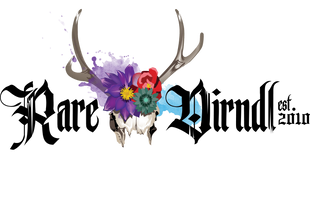Native Bavarian Herbs and Flowers
Germany is known for its diverse terrains.
The country is full of mountains and river valleys with various plant and flower life native to the country. It's lovely. There are so many different National Parks, waterfalls, mountains, and fields to explore.
A few of Germany's National Parks are:
- Black Forest National Park
- Harz National Park
- Berchtesgaden National Park
These parks have many different plants and flowers like Edelweiss, Astrantia, and Alpine Columbine. Some of these native plants and flowers even made their way into the United States.
Here's a list of some of the plant and flower life you'll encounter if you ever explore this beautiful country:
Edelweiss (Leontopodium nivale)

Edelweiss flowers are one of the most famous Bavarian flowers. It's a mountain flower belonging to the sunflower or daisy family and easily identifiable with its furry white petals.
The plant prefers rock gardens or rocky limestone at high altitudes -- about 1,800–3,000 meters (5,900–9,800 ft) high.
The edelweiss flower has been used in traditional folk medicine in the Alps for centuries. Different parts of edelweiss plants are used to treat abdominal pain, respiratory diseases, heart disease, and diarrhea. It was even known as the bellyache flower for a long time!
Want to know more about edelweiss flower? Read our blog post with fun and interesting facts about this Bavarian flower.
Bavarian gentian (Gentiana bavarica)

Bavarian gentian is a herbaceous perennial species of flowering plant in the Gentian family Gentianaceae. They have deep blue star shaped flowers that bloom in the late summer. These flowers are native to the European Alps.
The Bavarian gentian is known as the "Flower of Victory."
Stinging Nettle (Urtica dioica)

The Stinging Nettle is a medicinal plant that blooms annually. This plant is native to Europe, parts of Asia, and Western North Africa. However, the Stinging Nettle now grows worldwide (including in the United States).
The Stinging Nettle is known for its medicinal properties and has been used to treat painful muscles and joints, arthritis, anemia, and more. Additionally, these plants are used in food, tea, and textiles.
Alpine Rose (Rhododendron ferrugineum)

The Alpine Rose is an evergreen shrub with clusters of pink bell-shaped flowers that bloom throughout the summer.
These are well-known alpine flower that grow in high altitudes on more acidic soils.
These mountain flowers were traditionally used for their medicinal properties to combat diseases and gout.
Yellow Gentian (Gentiana lutea)

The Yellow Gentian is one of my favorites. They're tall plants full of yellow flowers. These plants are typically harvested in the Autumn and dried for later use.
This plant has a long history as an herbal bitter and is a base ingredient in many medicines. However, my favorite thing about this plant is that it's intensely bitter. So, before Hops, the gentian was used in brewing beers!
Yellow Alpine Anemone (Pulsatilla alpina)

This plant is a species of flower plant native to the mountain ranges of central and southern Europe.
This alpine flower is a bit finicky. It's suitable for growing in wet, drained soil in full sun. It's a robust plant but doesn't grow well in cold temperatures or wet winters.
European trollius (Trollius europaeus)

This is a perennial flowering plant of the Ranunculaceae family (the same family as the Yellow Alpine Anemone!)
The European trollius grows up to 60cm high with bright yellow flowers that bloom between June and August.
This alpine plant grows in damp soils and shady areas like the woods by a river or pond!
Silver Thistle (Carlina acaulis)

The Silver Thistle is another perennial plant native to the alpine regions of central and southern Europe.
This plant was named after Charlemagne. He searched for treatment against the plague and found this plant - The Silver Thistle contains several essential oils, including the antibacterial Carlina oxide.
This plants roots have medicinal properties and were used as a diuretic and cold remedy.
Venus (Cypripedioideae)

The Venus plant is a part of the orchid family, commonly known as lady's slipper orchids.
These flowers are really cool! They have slipper-shaped pouches of flowers. The pouch traps insects, and then the insects are forced to climb further into the flower. Where they'll then collect or deposit pollinia and fertilize the flower.
Alpine Columbine (Aquilegia alpina)

These flowers are native to Europe's high meadows and mountain slopes. These flowers bloom annually from late spring to early summer and may even re-bloom in the fall!
These plants are easy to grow, enjoy a sunny area and they attract hummingbirds and butterflies!
Germany is home to various plants, herbs, flowers, and trees. These plants, like the country, have a rich history and are used in foods, medicines, textiles, and even beer! One of my favorite things about Germany's rich plant life is it contributes to Germany's goal of being greenhouse gas neutral by 2045.
Sources:
https://www.petalrepublic.com/edelweiss-flower/
https://en.wikipedia.org/wiki/Gentiana_bavarica
http://encyclopaedia.alpinegardensociety.net/plants/Gentiana/bavarica
https://www.missouribotanicalgarden.org/gardens-gardening/our-garden/gardens-conservatories/international-gardens/bavarian-garden.aspx
https://www.landenweb.com/bavaria/plants/
https://en.wikipedia.org/wiki/Astrantia
https://www.britannica.com/plant/Arnica-montana
https://en.wikipedia.org/wiki/Arnica_montana
https://en.wikipedia.org/wiki/Rhododendron_ferrugineum
https://en.wikipedia.org/wiki/Gentiana_lutea
https://en.wikipedia.org/wiki/Pulsatilla_alpina
https://en.wikipedia.org/wiki/Trollius_europaeus
https://en.wikipedia.org/wiki/Carlina_acaulis
https://en.wikipedia.org/wiki/Aquilegia
https://en.wikipedia.org/wiki/Cypripedioideae
https://en.wikipedia.org/wiki/Leontopodium_nivale

Comments
Carrie Bangs said:
Very beautiful flowers, wonderful article!! Thank you!!